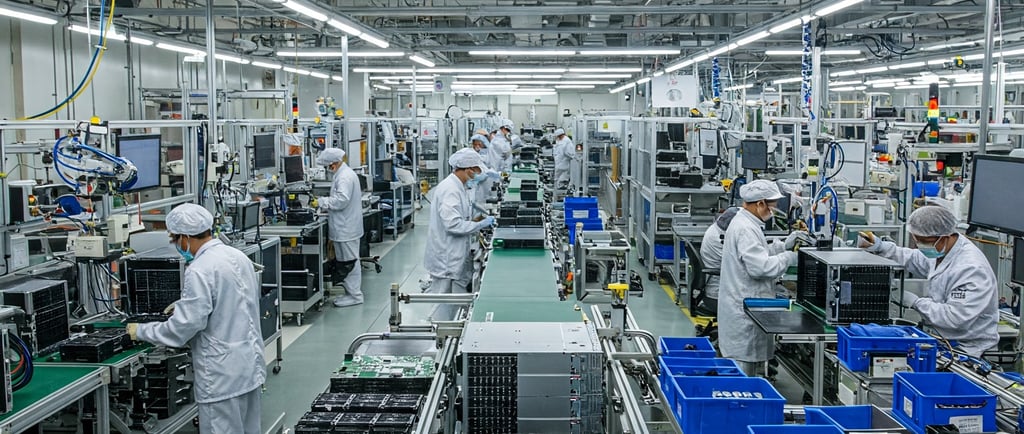Foxconn's Triumph Amidst Trade Turmoil: Decoding the 91% Profit Leap
In a surprising turn of events, Taiwan's Foxconn (2317.TW), the world's largest contract electronics manufacturer, today announced a staggering 91% surge in its first-quarter profit. This remarkable growth, amidst the ongoing turbulence in international trade, begs the question: how did the tech giant manage to not only weather the storm but thrive?
5/17/20256 min read


TAIPEI, May 14, 2025 - In a surprising turn of events, Taiwan's Foxconn (2317.TW), the world's largest contract electronics manufacturer, today announced a staggering 91% surge in its first-quarter profit. This remarkable growth, amidst the ongoing turbulence in international trade, begs the question: how did the tech giant manage to not only weather the storm but thrive?
The headline itself presents a compelling paradox. For years, the global electronics supply chain has been grappling with increasing geopolitical tensions, escalating tariffs, and the ripple effects of a fragmented international trade landscape. Companies reliant on intricate, cross-border manufacturing processes have faced rising costs, logistical nightmares, and an uncertain future. Yet, here stands Foxconn, a behemoth deeply embedded in this very ecosystem, reporting near doubling of its profits. A closer examination reveals a confluence of strategic foresight, shrewd market positioning, and an undeniable surge in a specific technological domain: Artificial Intelligence (AI).
The AI Tailwind: A Perfect Storm for Foxconn
The primary driver behind Foxconn's exceptional performance is the booming demand for AI servers. The company explicitly stated that its first-quarter profit leap was fueled by "continued strong demand for artificial intelligence servers," with AI server revenue reportedly surging by over 50% year-on-year. This isn't merely incremental growth; it signifies a fundamental shift in Foxconn's revenue streams and its strategic importance in the burgeoning AI infrastructure landscape.
Several factors contribute to this explosive demand:
The Generative AI Revolution: The past year has witnessed an unprecedented proliferation of generative AI applications, from large language models to image and video generation tools. These computationally intensive workloads necessitate powerful server infrastructure equipped with advanced processors, primarily GPUs and specialized AI accelerators.
Hyperscaler Investment: Major cloud service providers – the hyperscalers like AWS, Google Cloud, Microsoft Azure, and others – are aggressively investing in expanding their AI capabilities. This translates directly into massive orders for AI servers.
Enterprise AI Adoption: Beyond the cloud giants, enterprises across various sectors are increasingly deploying AI for tasks ranging from data analytics and machine learning to automation and customer service. This broad-based adoption further fuels the demand for AI-optimized hardware.
Taiwan's Semiconductor Prowess: Taiwan, and particularly the Taiwan Semiconductor Manufacturing Company (TSMC), holds a dominant position in the global semiconductor manufacturing, especially for the advanced chips crucial for AI. Foxconn's close ties to this ecosystem provide a significant advantage in sourcing and production.
Foxconn's Strategic Aces in a Shifting Trade Environment
While the AI boom provided a powerful tailwind, Foxconn's proactive strategies in navigating the choppy waters of international trade have been equally crucial to its success:
Early Bet on Regional Manufacturing: Years ago, anticipating the rise of geopolitical tensions and trade friction, Foxconn strategically embarked on a path of "regional manufacturing." This involved diversifying its manufacturing footprint beyond mainland China into regions like Southeast Asia, Mexico, the United States, and even Europe. This foresight has allowed the company to mitigate the impact of tariffs and supply chain disruptions concentrated in specific geographies. For instance, its growing presence in Mexico is becoming increasingly important as the United States considers extending tariffs to imports from there.
Deep Integration with Key Players: Foxconn's close partnership with NVIDIA, a leading designer of AI GPUs, is a cornerstone of its AI server success. As the primary assembler of NVIDIA's advanced AI server platforms, including the highly anticipated Blackwell-powered GB200 servers, Foxconn sits at the heart of the AI infrastructure build-out. This isn't just a supplier relationship; it's a strategic alliance that positions Foxconn as an indispensable partner in the AI ecosystem.
Focus on Automation and Efficiency: Foxconn has been consistently investing in automation and improving production yields across its facilities. This drive for efficiency not only enhances profitability but also provides greater flexibility in responding to fluctuating demand and potential labor shortages arising from trade-related disruptions.
Diversification Beyond Traditional Electronics: Recognizing the long-term risks associated with relying solely on consumer electronics assembly, Foxconn has strategically diversified into new growth areas like electric vehicles (EVs), digital health, and robotics. While these ventures are still in their early stages, they signal a commitment to building future revenue streams that are less susceptible to the vagaries of traditional electronics trade.
Agile Supply Chain Management: Decades of experience in managing complex, global supply chains have equipped Foxconn with sophisticated capabilities in logistics, sourcing, and risk management. This agility allows the company to adapt more effectively to trade policy changes and geopolitical uncertainties compared to less experienced players.
The Broader Context: International Trade in Disarray
Foxconn's success story unfolds against a backdrop of significant upheaval in international trade. The past few years have witnessed a rise in protectionist measures, trade wars, and a growing trend towards regionalization.
US-China Trade Tensions: The ongoing trade dispute between the United States and China has been a major source of disruption for the electronics industry. Tariffs on Chinese-made goods, including electronic components, have increased costs and forced companies to re-evaluate their supply chains. While temporary tariff truces may offer short-term relief, the underlying tensions and the potential for future trade barriers remain a significant concern.
Expanding Tariff Landscape: The United States has also imposed tariffs on goods from other countries, including steel, aluminum, and even potentially Mexico, further complicating global trade flows and increasing uncertainty for manufacturers with international supply chains.
Geopolitical Instability: Beyond tariffs, broader geopolitical tensions and conflicts can disrupt supply chains, create logistical challenges, and impact market demand. The need for resilient and diversified supply chains has become paramount in this environment.
Currency Fluctuations: Volatility in exchange rates can significantly impact the profitability of multinational companies like Foxconn, which operate across numerous countries and currencies. The appreciation of the New Taiwan dollar, for instance, poses a potential headwind to Foxconn's revenue when converted back to its reporting currency.
Navigating the Future: Challenges and Opportunities
Despite its impressive first-quarter performance, Foxconn remains cautiously optimistic about the full year. While the demand for AI servers is expected to remain strong, the company has downgraded its previous forecast of "strong growth" to "significant growth," citing ongoing uncertainties in the global economic and trade environment, including fluctuating exchange rates and evolving US tariff policies.
Looking ahead, Foxconn faces both challenges and significant opportunities:
Challenges:
Sustaining AI Server Growth: While the AI market is booming, competition is intensifying. Foxconn needs to maintain its technological edge and its strong relationships with key AI players to sustain its current growth trajectory.
Managing Trade Policy Volatility: The unpredictable nature of international trade policies remains a significant risk. Foxconn needs to remain agile and adaptable in its manufacturing and supply chain strategies to mitigate potential future disruptions.
Currency Risks: Fluctuations in exchange rates can erode profitability. Implementing effective hedging strategies will be crucial to managing this risk.
Diversification Execution: The success of Foxconn's diversification efforts into new sectors like EVs and digital health will be critical for its long-term growth and resilience. These are capital-intensive industries with their own set of challenges and competition.
Component Supply Chain Resilience: Even with its global footprint, Foxconn relies on a complex network of component suppliers. Ensuring the resilience and security of this supply chain in the face of geopolitical risks is an ongoing challenge.
Opportunities:
Continued AI Dominance: The demand for AI infrastructure is expected to continue its rapid growth in the coming years. Foxconn's strong position in this market provides a significant growth engine.
Expanding EV Market: The global transition to electric vehicles presents a massive opportunity for Foxconn to leverage its manufacturing expertise and establish itself as a key player in the EV supply chain.
Growth in Digital Health and Robotics: These emerging sectors offer long-term growth potential for Foxconn as it diversifies its revenue streams.
Leveraging Taiwan's Strategic Importance: Taiwan's crucial role in the global semiconductor supply chain positions Foxconn favorably, especially as companies seek reliable and secure manufacturing partners outside of potentially high-risk regions.
Technological Advancement: Foxconn's ongoing investments in R&D, particularly in areas like next-generation communications and semiconductors (such as its advancements in SiC MOSFETs), can create new competitive advantages.
Conclusion: A Testament to Adaptability and Strategic Vision
Foxconn's remarkable 91% profit surge in the first quarter of 2025 is a powerful testament to the company's adaptability, strategic foresight, and its ability to capitalize on emerging technological trends amidst a challenging global trade environment. While the chaos in international trade continues to cast a shadow of uncertainty, Foxconn's early bet on regional manufacturing, its deep integration into the booming AI server market, and its ongoing diversification efforts have positioned it for continued success. The company's performance serves as a compelling case study in how global manufacturers can navigate geopolitical headwinds and thrive by embracing strategic agility and focusing on high-growth sectors. As the world increasingly embraces the power of artificial intelligence, Foxconn, at the heart of its hardware infrastructure, appears poised to reap significant rewards.
